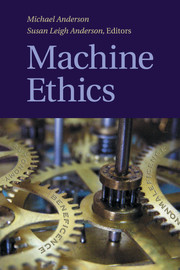Book contents
- Frontmatter
- Contents
- General Introduction
- PART I THE NATURE OF MACHINE ETHICS
- PART II THE IMPORTANCE OF MACHINE ETHICS
- PART III ISSUES CONCERNING MACHINE ETHICS
- PART IV APPROACHES TO MACHINE ETHICS
- Introduction
- 14 Towards the Ethical Robot
- 15 Asimov's Laws of Robotics
- 16 The Unacceptability of Asimov's Three Laws of Robotics as a Basis for Machine Ethics
- 17 Computational Models of Ethical Reasoning
- 18 Computational Neural Modeling and the Philosophy of Ethics
- 19 Architectures and Ethics for Robots
- 20 Piagetian Roboethics via Category Theory
- 21 Ethical Protocols Design
- 22 Modeling Morality with Prospective Logic
- 23 An Integrated Reasoning Approach to Moral Decision Making
- 24 Prototyping N-Reasons
- 25 There Is No “I” in “Robot”
- 26 Prospects for a Kantian Machine
- 27 A Prima Facie Duty Approach to Machine Ethics
- PART V VISIONS FOR MACHINE ETHICS
- References
17 - Computational Models of Ethical Reasoning
Challenges, Initial Steps, and Future Directions
from PART IV - APPROACHES TO MACHINE ETHICS
Published online by Cambridge University Press: 01 June 2011
- Frontmatter
- Contents
- General Introduction
- PART I THE NATURE OF MACHINE ETHICS
- PART II THE IMPORTANCE OF MACHINE ETHICS
- PART III ISSUES CONCERNING MACHINE ETHICS
- PART IV APPROACHES TO MACHINE ETHICS
- Introduction
- 14 Towards the Ethical Robot
- 15 Asimov's Laws of Robotics
- 16 The Unacceptability of Asimov's Three Laws of Robotics as a Basis for Machine Ethics
- 17 Computational Models of Ethical Reasoning
- 18 Computational Neural Modeling and the Philosophy of Ethics
- 19 Architectures and Ethics for Robots
- 20 Piagetian Roboethics via Category Theory
- 21 Ethical Protocols Design
- 22 Modeling Morality with Prospective Logic
- 23 An Integrated Reasoning Approach to Moral Decision Making
- 24 Prototyping N-Reasons
- 25 There Is No “I” in “Robot”
- 26 Prospects for a Kantian Machine
- 27 A Prima Facie Duty Approach to Machine Ethics
- PART V VISIONS FOR MACHINE ETHICS
- References
Summary
Introduction
How can machines support, or even more significantly replace, humans in performing ethical reasoning? This is a question of great interest to those engaged in Machine Ethics research. Imbuing a computer with the ability to reason about ethical problems and dilemmas is as difficult a task as there is for Artificial Intelligence (AI) scientists and engineers. First, ethical reasoning is based on abstract principles that cannot be easily applied in formal, deductive fashion. Thus the favorite tools of logicians and mathematicians, such as first-order logic, are not applicable. Second, although there have been many theoretical frameworks proposed by philosophers throughout intellectual history, such as Aristotelian virtue theory (Aristotle, edited and published in 1924), the ethics of respect for persons (Kant 1785), Act Utilitarianism (Bentham 1789), Utilitarianism (Mill 1863), and prima facie duties (Ross 1930), there is no universal agreement on which ethical theory or approach is the best. Furthermore, any of these theories or approaches could be the focus of inquiry, but all are difficult to make computational without relying on simplifying assumptions and subjective interpretation. Finally, ethical issues touch human beings in a profound and fundamental way. The premises, beliefs, and principles employed by humans as they make ethical decisions are quite varied, not fully understood, and often inextricably intertwined with religious beliefs. How does one take such uniquely human characteristics and distil them into a computer program?
Information
- Type
- Chapter
- Information
- Machine Ethics , pp. 297 - 315Publisher: Cambridge University PressPrint publication year: 2011
References
Accessibility standard: Unknown
Why this information is here
This section outlines the accessibility features of this content - including support for screen readers, full keyboard navigation and high-contrast display options. This may not be relevant for you.Accessibility Information
- 6
- Cited by
